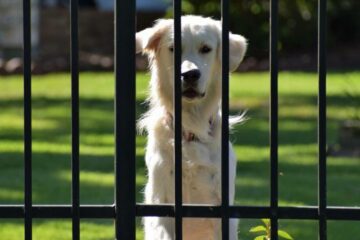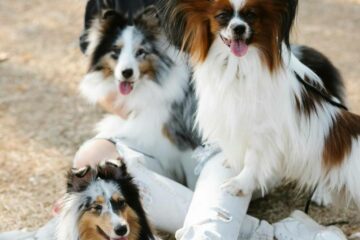Are Groundhogs Dangerous to Dogs? Will They Attack, Bite?
Are groundhogs dangerous to dogs? These wild critters (also known as woodchucks) may be cute, but just how careful do you need to be? Will groundhogs attack dogs? Do groundhogs bite dogs? And will your dog keep groundhogs away from your yard?
We’ll answer all these questions and also teach you how to train your dog to keep back and stay calm around groundhogs. Next, we’re going to cover a tough one: if your dog killed a groundhog, what do you do next? We’ll fill you in on exactly what to do, along with letting you know if a dog can get rabies from biting a groundhog along with other concerns. Keep reading!
Are Groundhogs Dangerous to Dogs?

Groundhogs are not dangerous to dogs generally. They prefer to avoid confrontations, and will usually retreat to their burrows when they feel threatened. However, if cornered, they may bite in self-defense, which can pose risks, such as injury or transmission of rabies. Hence, while the danger is low, it’s important to prevent encounters between groundhogs and dogs as much as possible.
Can Groundhogs Hurt Dogs?
Yes, groundhogs can hurt dogs potentially if they feel threatened or cornered. Groundhogs have sharp teeth and strong jaws that can cause painful bites. In addition, they can carry diseases, like rabies, which can be transmitted to dogs through a bite.
Can a Groundhog Kill a Dog?
While it’s extremely unlikely for a groundhog to kill a dog, serious injuries can occur if a dog provokes a groundhog. If a large dog, or one with a high prey drive, aggressively chases or attacks a groundhog, the groundhog might defend itself, which can lead to a potentially dangerous situation.
Teaching Your Dog the ‘Stay’ Command
Training your dog to follow the ‘stay’ command is important to avoid dangerous situations. Start by asking your dog to sit. Then, open your palm in front of you, facing your dog, and say ‘stay’. Take a few steps back. If your dog stays, give them a treat and praise.
Repeat this over time, gradually increasing the distance between you and your dog. This can help ensure your dog’s safety around groundhogs and other potential dangers.
Teaching Your Dog the ‘Leave It’ Command
The ‘leave it’ command is another important command to keep your dog safe. To teach this command, hold a treat in both hands. Show your dog one closed fist with the treat inside and say, ‘leave it.’ Ignore the behaviors your dog shows to get the treat, and once they stop trying, give them the treat from the other hand.
Practice this regularly until your dog moves away from the first fist when you say the command ‘leave it’. This can prevent your dog from approaching, attacking, or eating something potentially harmful, like a defensive groundhog.
But you should know that while these steps will get your dog to be safe around groundhogs, the underlying behavioral issues (prey drive, anxiety, overexcitement) that were causing all of this to begin with will still be present. And until you address those, any positive changes you see are only going to be temporary.
“Well, how do I make these changes last?”
By getting your dog to truly choose to follow your direction, that’s how. I tried many times to write out how you can do that before deciding it made more sense to just link you to the free video series that explains it better than I’d ever be able to.
The series is by a man named Dan who is one of the world’s leading dog obedience trainers. In it, he teaches you how to put an end to things like when your dog gets aggressive with groundhogs and all other misbehavior using his fast and easy-to-follow methods.
In the first video, Dan will reveal to you why the two most common methods of dog training only doom you to failure. You can watch the video now by clicking here. Follow the proven system he’ll show you in his series and you’ll never have to spend another second worrying about your dog not staying calm around groundhogs ever again!
Will Groundhogs Attack Dogs?

Groundhogs will not attack dogs usually, as they are typically non-aggressive and prefer to avoid confrontation. However, if they feel threatened or cornered, they may defend themselves, potentially causing harm to the dog.
Most often, groundhogs will choose flight over fight but can become defensive when protecting their burrows or offspring. A dog’s size, breed, and behavior can also factor into whether a groundhog might feel threatened enough to attack.
- Groundhog Behavior: Groundhogs are generally solitary creatures that spend much of their time burrowing. These animals are more likely to retreat into their burrows than engage in a conflict. However, during the breeding season or when they have young to protect, they can become more defensive.
- Threat Perception: Groundhogs perceive larger dogs or those breeds known for hunting or digging as more of a threat, increasing the chance of a defensive reaction. Similarly, if a dog harasses a groundhog or attempts to invade its burrow, the groundhog may feel compelled to protect itself.
- Potential Risks: While groundhog bites are relatively rare, they can still pose a risk to dogs. Groundhogs have sharp teeth and strong jaws that can cause significant injuries. Moreover, they can carry diseases like rabies which can be transmitted to dogs through a bite.
- Preventive Measures: It is advisable to keep dogs on a leash, especially in areas known to have groundhogs. If groundhogs are present in your yard, consider humane removal options or fencing to discourage their presence and keep your dog safe. We also have commands you should learn in the first section.
While groundhogs are not typically aggressive creatures, they can defend themselves if they feel threatened, especially by dogs. It’s best to prevent interactions between dogs and groundhogs where possible, as this is the most effective way to ensure the safety of both animals. Learn more in the first section.
You should get this issue with your dog taken care of now, as doing so will also make them safe for any possible encounters with other wildlife. You’ll then have no need to worry about things like moles being poisonous to dogs. The possibility of random meetings between your dog and a bear, your dog and a snake, your dog and a raccoon, your dog and a beaver, or even your dog and a badger will be nothing to stress about at all.
Groundhog Bites Dog

Groundhogs can bite dogs if they feel threatened. While groundhogs are usually not aggressive, they might defend themselves if cornered or attacked. Groundhog bites can be painful and there is a risk of disease transmission, including rabies. If your dog is bitten by a groundhog, seek veterinary attention immediately.
Do Groundhogs Bite Dogs?
Groundhogs do not bite dogs normally. They are typically non-aggressive animals that prefer to retreat into their burrows when they sense danger or feel threatened. However, if a dog invades their space, particularly near its burrow, the groundhog might react defensively and bite the dog in self-defense.
That’s why it’s very important for dog owners to ensure their pets are kept away from areas where groundhogs are known to inhabit to avoid any such confrontations. Learn commands you should know that will help with this in the first section.
Dog Bitten by Groundhog
In the unfortunate event that your dog has been bitten by a groundhog, you must treat and seek veterinary help immediately. Begin by gently cleaning the wound with warm water and mild soap to remove any immediate contamination.
Once this is done, contact your vet right away. Depending on the specifics of your dog’s vaccination history and the severity of the bite, your vet may recommend a rabies booster or an antibiotic course to prevent possible infection.
Preventing Groundhog Encounters
One of the best strategies to prevent any encounters between your dog and a groundhog is to discourage groundhogs from venturing onto your property. This can be achieved by sealing off any access points to potential burrows and removing potential food sources.
In addition to these measures, you also need to train your dog to obey certain commands like ‘leave it’ and ‘stay’. These commands can deter your dog from approaching or provoking wildlife, thereby reducing the risk of bites. We explain how to do these in the first section.
Handling Wildlife Interactions
It’s important to remember that any interaction between your dog and wildlife has the potential to become a dangerous situation. Always ensure that your dog is supervised when outdoors, especially in areas known for being habitats to groundhogs and other wildlife.
For further advice on safely managing these interactions, don’t hesitate to consult with a local wildlife expert or your veterinarian. They can provide you with region-specific guidance and prevention methods. Learn more about keeping your dog safe in the first section.
Groundhogs and Dogs: Will They Keep Away?
Dogs, particularly large ones or those known for hunting and digging, can act as a deterrent to groundhogs. The scent and activity of dogs may discourage groundhogs from setting up residence in your yard. However, this isn’t a guaranteed method to keep groundhogs away, especially if food sources are plentiful.
- Dog Scent: Groundhogs possess an acute sense of smell, and they often perceive the scent of a dog as indicative of a potential predator. This perception might encourage them to steer clear of your property. Some dog owners have even found success in strategically spreading dog hair or using dog-based repellents around their yards to amplify this effect and deter groundhogs from taking up residence.
- Dog Activity: Regular canine activity in a yard can serve as an additional deterrent to groundhogs. Dogs, particularly those breeds that are known for their territorial nature and propensity for digging, can create an environment that’s less appealing to groundhogs. The frequent running, digging, and general presence of a dog can disrupt the quiet, undisturbed conditions that groundhogs usually prefer for their burrows.
- Limited Effectiveness: It’s important to note that a dog’s presence isn’t a foolproof method for keeping groundhogs away. Groundhogs that have plentiful food sources or those that have become accustomed to dogs may not be as easily deterred. This limited effectiveness means relying solely on a dog as a deterrent might not yield the desired results.
- Other Prevention Methods: To keep groundhogs at bay more effectively, consider incorporating additional preventive measures. These might include eliminating readily available food sources, installing fences that reach deep into the ground to prevent burrowing, using commercially available repellents, or seeking assistance from a professional for humane removal if groundhogs have already established a burrow on your property.
While the presence and activity of dogs can help discourage groundhogs from entering your property, it should not be viewed as a complete solution. Utilizing a multifaceted approach that includes the presence of a dog and other preventive measures is the most effective strategy to keep groundhogs away from your yard. Learn more to know in the first section.
Dog Killed Groundhog, What Do I Do?
If your dog killed a groundhog, it’s important to contact your veterinarian as soon as possible. Groundhogs can carry diseases, such as rabies, which can be transmitted to your dog. Keep your dog away from the groundhog’s carcass, and avoid handling it directly if possible. Remember that this could also indicate a need for better control of your dog’s behavior around wildlife.
Can a Dog Get Rabies From Biting a Groundhog?
Yes, a dog can get rabies from biting a groundhog potentially if the groundhog was infected. Rabies is a virus that affects the central nervous system and it can be transmitted through the saliva of an infected animal.
It’s very important that you contact your veterinarian immediately, particularly if your dog’s rabies vaccinations are not up to date. You should also report the incident to local health or animal control authorities, as they might need to test the groundhog for diseases.
What to Do Immediately After the Incident
After ensuring your dog’s safety, check for any injuries or signs of illness. If your dog is uninjured and current on all vaccinations, it’s still best to consult your vet. If possible, isolate the carcass without touching it directly—use gloves and a shovel. Do not allow other animals or humans to come in contact with the groundhog.
Preventing Future Incidents
Prevention is the best approach to avoid future incidents. Train your dog to follow the “leave it” command, which we explained in the first section. You should also ensure your yard is secure, and attempt to make it less attractive to groundhogs by blocking off potential burrow sites and removing food sources.
Consult a Veterinarian and Local Animal Control
Always consult with your veterinarian following such an incident. They can provide advice tailored to your dog’s health history and current situation. Moreover, local animal control or wildlife authorities can provide information and support in handling the carcass and in efforts to deter wildlife from your property.
Groundhog Hunting Dog Breeds
Several breeds of dogs are known for their groundhog-hunting abilities. These dogs have the instinct, drive, and physical attributes necessary for hunting, which include a strong sense of smell, high prey drive, endurance, and physical strength.
Here’s a list of 10 dog breeds renowned for their groundhog-hunting skills:
- Dachshund: Originally bred to hunt badgers, Dachshunds’ small size and strong digging capabilities make them great for getting into groundhog burrows.
- Jack Russell Terrier: Known for their high energy and tenacity, Jack Russells are skilled hunters. They’re compact enough to enter burrows and chase out groundhogs.
- Beagle: Beagles possess an exceptional sense of smell and a high prey drive, making them good groundhog hunters. They are persistent trackers and known for their “bay” when they locate their prey.
- Border Terrier: As part of the terrier group, Border Terriers have a strong instinct to dig and chase, which can be effectively used for hunting groundhogs.
- West Highland White Terrier: This breed is small, energetic, and possesses a strong prey drive. They were originally bred to hunt rodents, including groundhogs.
- Airedale Terrier: Known as the “King of Terriers,” the Airedale is the largest terrier breed and highly capable in hunting. They’re brave, determined, and have an excellent nose for tracking.
- Rat Terrier: As their name suggests, Rat Terriers are excellent vermin hunters. They’re agile, have a high prey drive, and are great diggers – traits ideal for hunting groundhogs.
- Mountain Cur: These dogs are native to the United States and have a long history of hunting small game. They are courageous and tenacious, making them good groundhog hunters.
- Norfolk Terrier: Small but mighty, Norfolk Terriers are known for their ability to hunt and kill vermin. They’re agile and have a great sense of smell, useful for tracking down groundhogs.
- Miniature Schnauzer: Despite their small size, Miniature Schnauzers are fearless and have a high prey drive. These traits make them effective for hunting groundhogs.
These breeds, among others, have proven their abilities in hunting groundhogs. However, you need to remember that not all individuals within these breeds will show the same ability, and a dog’s upbringing and training also significantly impact their hunting skills. Always ensure any hunting activities are conducted humanely and responsibly.
I’m sure you’re ready to not worry about the issue of groundhogs and dogs anymore, so I’ll let you get started on things. Good luck with all of this, and thanks for reading our article “Are Groundhogs Dangerous to Dogs? Will They Attack, Bite?”





